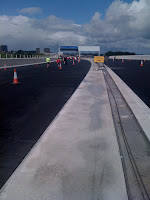The view here of the cottages from the east shows the two bedroomed stone building on the left of the photo and the four bedroomed one on the right. The larger cottage is finished partly in white render and will also have larch clad areas on the unfinished section you can see. The brown material visible is Pavatherm which is a compressed wood fibre board used as an external insulation material. That area will be larch clad which will age fairly quickly to a mellow silvery grey. The materials used fit very well with the local vernacular and have also been used on our own house. The red sandstone is well over 150 years old and is typically 2feet thick.
 The official naming of the two bedroomed cottage...
The official naming of the two bedroomed cottage... We commissioned a name stone which is placed high on the west gable of the cottage. I'm really pleased with the way the whole building looks now, the cleaned up stone is looking all the more splendid in the winter sunshine. For a quick reminder of how it looked check here.
We commissioned a name stone which is placed high on the west gable of the cottage. I'm really pleased with the way the whole building looks now, the cleaned up stone is looking all the more splendid in the winter sunshine. For a quick reminder of how it looked check here.Both cottages have access ramps and at grade entrances for wheelchair users. They also have plenty of big windows to maximise those views of our beautiful surroundings, being strong on energy conservation the windows are Argon filled double glazed with sustainable timber frames. The interior of The Old Dairy. The living space is a full height room with high level windows as well as ground floor sliding doors to the patio. You can just see the pipe which will serve the wood burning stove on the left.
The interior of The Old Dairy. The living space is a full height room with high level windows as well as ground floor sliding doors to the patio. You can just see the pipe which will serve the wood burning stove on the left. 
The living space of the larger cottage is impressively large and, again, has big windows for big views.
 The interior of The Old Dairy. The living space is a full height room with high level windows as well as ground floor sliding doors to the patio. You can just see the pipe which will serve the wood burning stove on the left.
The interior of The Old Dairy. The living space is a full height room with high level windows as well as ground floor sliding doors to the patio. You can just see the pipe which will serve the wood burning stove on the left. 
The living space of the larger cottage is impressively large and, again, has big windows for big views.




















 The monster concrete pump pouring the floor slabs for the two adjacent cottages, this covers the underfloor heating which is attached to the steel mesh. With the heating encased in the concrete slab this provides a high level of thermal mass to stabilise the internal temperature of the properties. We used the same principle on the main house which we built 3 1/2 years ago and it really works well, alongwith the high levels of insulation and air-tightness.
The monster concrete pump pouring the floor slabs for the two adjacent cottages, this covers the underfloor heating which is attached to the steel mesh. With the heating encased in the concrete slab this provides a high level of thermal mass to stabilise the internal temperature of the properties. We used the same principle on the main house which we built 3 1/2 years ago and it really works well, alongwith the high levels of insulation and air-tightness.






 We're using
We're using 






 As we climbed the shoulder onto the ridge the rain came down, paths were running as small streams, and as we tipped onto the top we were met with a strong wind which drove the misty rain directly at us. No stopping, no views to admire, we just put our heads down and dropped down into Balmaha as soon as we could. On day1 of the West Highland Way we encountered over 100 people, on day2 it was significantly less. Partly this will be due to differing start times but also many we met had chosen a low level option to avoid Conic Hill. Those who we met up the hill seemed slightly manic and happy and we had some nice wee chats with fellow walkers.
As we climbed the shoulder onto the ridge the rain came down, paths were running as small streams, and as we tipped onto the top we were met with a strong wind which drove the misty rain directly at us. No stopping, no views to admire, we just put our heads down and dropped down into Balmaha as soon as we could. On day1 of the West Highland Way we encountered over 100 people, on day2 it was significantly less. Partly this will be due to differing start times but also many we met had chosen a low level option to avoid Conic Hill. Those who we met up the hill seemed slightly manic and happy and we had some nice wee chats with fellow walkers.


 And this one is at Sallochy Bay, about an hour south of our journey's end, when the sun came through and finally beat the rainclouds away for the rest of the day.
And this one is at Sallochy Bay, about an hour south of our journey's end, when the sun came through and finally beat the rainclouds away for the rest of the day.











